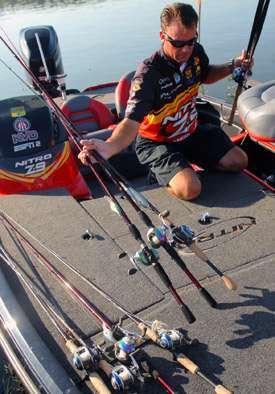
Recently here on Bassmaster.com, Kevin VanDam identified three rods that every bass angler should carry. (KVD Helps You Choose a Fishing Rod)
1. A 6-foot, 10-inch, medium-heavy action baitcasting model for spinnerbait, crankbait, lipless crankbait, jerkbait and topwater applications
2. A 7-foot, medium action spinning rod for finesse applications such as drop shotting, shaky heads and weightless worms
3. A 7-foot, 2-inch heavy action casting rod for heavy cover bass fishing such as flipping or pitching and for working topwater frogs.
Now we’ll see what Skeet Reese, 9-time Classic qualifier and 2007 Toyota Tundra Bassmaster Angler of the Year, has to say about equipping those rods with the proper reels.
“To begin with I’d say that the same model reel will do a good job on both casting rods,” he says. “I’d recommend a high-quality, high speed reel. Something with quite a few ball bearings and a gear ratio between 6.1:1 and 6.4:1 should be about right for most bass fishing.
“The bearings are important because they give the reel smooth casting and retrieving performance. That’s important for efficiency and long wear. In basic terms, the more ball bearings the better.
“A high gear ratio is important because it’s usually easier to slow down than it is to speed up, at least for me. That’s especially true if you’re going to be fishing all day in a tournament.”
Reese’s personal choice is the Abu Garcia Revo STX model. It’s designed with 11 ball bearings and a 6.4:1 gear ratio. “It’s a perfect choice for both rods. It’s fast enough to handle most speed fishing applications and, with 11 bearings, it as smooth as any reel on the market.
“We designed it with oversized handles for increased torque as well as more leverage and cranking power. This has been a problem with some high speed reels in the past, but not anymore. We took care of that with the Revo. And, with its low profile, it’ll suit just about any angler, regardless of their hand size.”
Reese does, however, make one exception — anglers who do a lot of pitching and flipping should consider something with an even higher gear ratio. For them he recommends a Revo STX-HS. It has a 7.1:1 gear ratio. Reese believes the higher speed is necessary to get the bait back rapidly so it can be pitched or flipped again without wasting time.
“When you’re flipping or pitching, all you’re doing is letting the bait fall for a second or two. The faster you can get it back, the faster you can pitch again. Over the course of a tournament day that will allow you to fish as many as 100 additional targets. You need to do that if you expect to win.”
When choosing a spinning reel Reese says the most important consideration is the drag. The gear ratio and ball bearing count are secondary. “The drag is everything on a spinning reel. If you’re buying a spinning reel always ask yourself if it offers the best drag available. If the answer is no, don’t buy it no matter what other features it may offer.
“Think about it for a minute. You’re generally fishing with 6, 8 or 10-pound-test line with spinning tackle. There’s no room for error and no way to horse a fish to the boat. Your drag has to slip and slip in a smooth and trouble-free manner. If it doesn’t, you’ll break-off. “
His reel choice for most spinning applications is an Abu Garcia Cardinal 800 Series, specifically model C804. “It’s perfect for 8-pound-test line, but it’ll handle 6 or 10 when required.
“There are a few exceptions. If you always fish very clear water with lighter line, you might want to go a size smaller. Or, if you typically fish stained water and like to throw 10-pound test you might want to go one size bigger. But, overall the Cardinal C804 is the best choice.”
The Revo STX reel sells for around $200; the Cardinal C804 for around $140.




